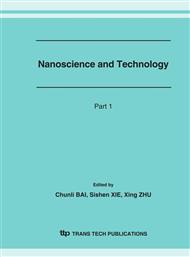p.781
p.785
p.789
p.793
p.797
p.801
p.805
p.809
p.813
Field Emission Characteristics of AlN Coated Silicon Nanocone Arrays
Abstract:
Nanoscaled silicon cone arrays were formed on mirror-polished silicon wafers by plasma etching using hot filament chemical vapor deposition (HFCVD) system. A mixture of CH4 and H2 was introduced during silicon cone formation. AlN films were coated on Si cone arrays using radio frequency (RF) magnetron sputtering system. Scanning electrons microscopy (SEM) was employed to characterize the morphology of silicon cone arrays before and after AlN coating. The field emission characteristics of AlN coated silicon cone arrays,uncoated silicon cone arrays and AlN films were studied and compared, and the silicon cone arrays with AlN coating showed the best enhanced electron emission properties due to the negative electron affinity of AlN coating layer and the high aspect ratio of silicon cone. For AlN coated silicon cone arrays, a slight hysteresis between the upward and downward voltage sweeps was also observed and the field emission currents from AlN coated Si nanocone arrays decreased with the increase of the thickness of AlN films, which could be mainly attributed to the space charge buildup in AlN film with wide band gap.
Info:
Periodical:
Pages:
797-800
Citation:
Online since:
March 2007
Authors:
Price:
Сopyright:
© 2007 Trans Tech Publications Ltd. All Rights Reserved
Share:
Citation:


